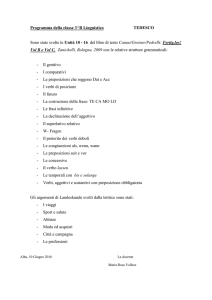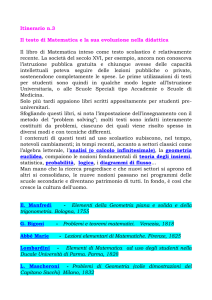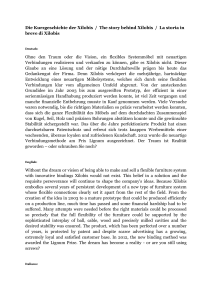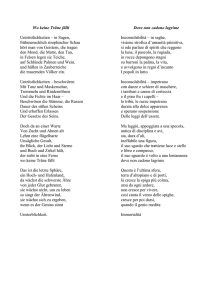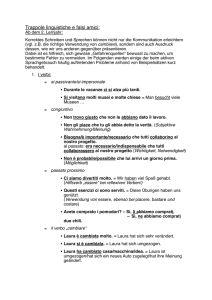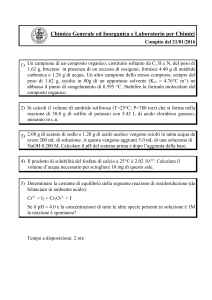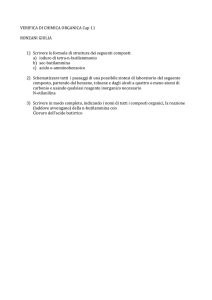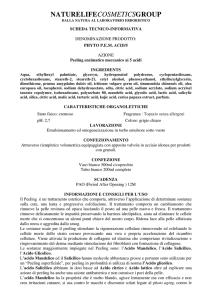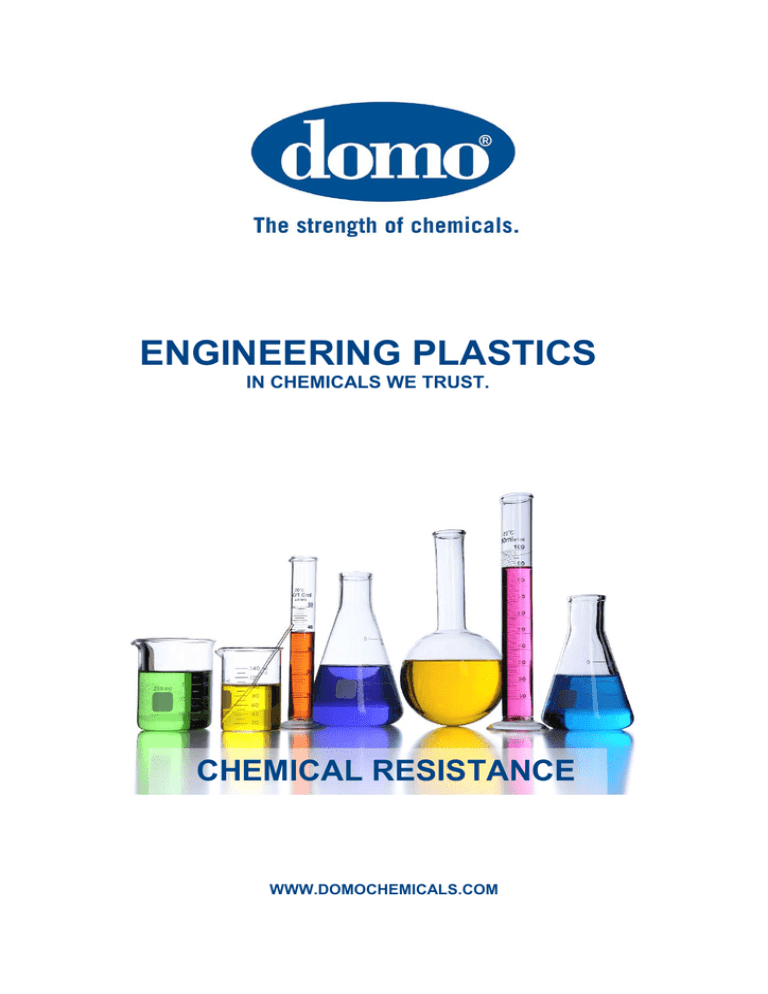
ENGINEERING PLASTICS
IN CHEMICALS WE TRUST.
CHEMICAL RESISTANCE
WWW.DOMOCHEMICALS.COM
CHEMICAL RESISTANCE
DOMAMID®
AND
ECONAMID®
Polyamides are thermoplastic
polymers characterized by good
physical and mechanical properties: good impact strength, low
friction coefficient and good
toughness. These properties can
be modulated, by compounding
to adapt the material to different
end uses. The versatility of polyamides comes from the ease of
moulding and from the possibility
to obtain a wide range of colours
with good surface finishing (Polyamides can be easily moulded
and they can be coloured with
good finishing): these resins are
used in a wide variety of products
and industries such as automotive, electrotechnics, furnishing,
hydraulics and food stuff.
DOMO Engineering Plastics produces
engineering
plastics,
DOMAMID® and
branded
ECONAMID®, based on Nylon 6
and 6.6.
CHEMICAL RESISTANCE
CHEMISCHE BESTÄNDIGKEIT
DOMAMID®
UND
ECONAMID®
Polyamide sind thermoplastische
Polymere, die sich durch gute physikalische und mechanische Eigenschaften, Festigkeit und Schlagzähigkeit sowie niedrige Reibungskoeffizienten auszeichnen. Diese Eigenschaften können durch Compoundierung verändert werden,
um das Material an verschiedene
Anwendungen anzupassen. Einfache Formbarkeit und eine breite
Palette an Farben zusammen mit
Oberflächenveredlung machen Polyamide vielseitig einsetzbar. Deshalb finden sich Polyamide in einer
Vielzahl von Produkten und Industriezweigen wieder.
Dazu zählen Automobilbau, Elektrotechnik, Beschichtungen, Hydraulikanwendungen und Lebensmittelverpackungen sowie Sportgerätebau.
DOMO Engineering Plastics produziert die technischen Kunststoffe
DOMAMID® und ECONAMID®
auf Basis von Polyamid 6 und 6.6.
DOMO Engineering Plastics
RESISTENZA CHIMICA
DOMAMID®
ED
ECONAMID®
Le poliammidi sono polimeri termoplastici con ottime proprietà
fisico-meccaniche: elevata resistenza all’urto e alla trazione,
basso coefficiente di attrito e
grande tenacità. Caratteristiche,
queste, che possono essere modulate, in funzione dell’utilizzo finale, variando ad esempio il contenuto e la tipologia di carica. La
versatilità di queste resine, generata dalla facilità di stampaggio,
anche di particolari complessi, associata alla possibilità di ottenere
un’ampia gamma di colorazioni
con buona finitura estetica vede il
loro impiego in numerosi settori:
dall’automotive all’industria elettrotecnica, dall’arredamento al
settore alimentare.
Le principali resine di base utilizzate da DOMO Engineering Plastics nella formulazione dei suoi
prodotti, registrati con marchio
DOMAMID® ed ECONAMID®,
sono le poliammidi 6 e 6.6.
2
From a chemical point of view,
polyamides are polymers in
which the repeating units in the
molecular chain are linked together by amide groups with the
general chemical formula CO-NH.
They may be produced by the reaction of a carboxyl (COOH)
group and an amine (NH2) group,
or they may be formed starting
from lactam rings. This chemical
structure is very important to understand the reactivity of polyamides. In fact, especially if they
possess the ability for hydrogen
bonding can interact with C=O e
N-H bonds, causing swelling of
nylon.
Strong acids cause degradation of
polymeric chain of polyamides 6
and 6.6: the hydroxonium cations
(H3O+) interact with amide group
causing acid induced hydrolysis.
Diluted bases do not effectively
affect nylon 6 and 6.6: alkaline
hydrolysis of polyamides is quite
slow.
In the table below there are some
indications regarding the chemical resistance of polyamides 6
and 6.6 to several chemicals reagents at room temperature (23
°C).
CHEMICAL RESISTANCE
Aus chemischer Sicht sind Polyamide Polymere Werkstoffe, in
denen die Wiederholeinheiten
der Molekülkette durch Amidgruppen mit der allgemeinen Formel CO-NH verbunden sind. Sie
können durch Reaktion von Carboxyl- (COOH) und primärem
Aminogruppen (NH2), sowie ausgehend von Lactamringen, hergestellt werden. Die chemische
Struktur der Polyamide ist wesentlich zum Verständnis ihres
Verhaltens und ihrer Reaktivität.
So wechselwirken polare Moleküle, insbesondere solche die
Wasserstoffbrückenbindungen
eingehen können, mit den Amidgruppen und verursachen so eine
Quellung des Polyamids.
Starke Säuren führen zu einem
Abbau der Polymerketten von
Polyamid 6 und 6.6: Die Hydronium-Ionen (H3O+) wechselwirken mit den Amidgruppen und
verursachen sauer induzierte
Hydrolyse. Verdünnte Basen beeinträchtigen Polyamid 6 und 6.6
kaum: Basisch induzierte Hydrolyse von Polyamiden ist vergleichsweise langsam.
DOMO Engineering Plastics
Da un punto di vista più strettamente chimico, le poliammidi
sono caratterizzate da un gruppo
ammidico CO-NH, derivato dalla
reazione di condensazione di un
gruppo carbossilico (COOH) e di
un gruppo amminico (NH2), o
dall’apertura di un anello di lattame: tale gruppo è fondamentale nel determinare la resistenza
delle poliammidi agli agenti chimici. Molecole contenenti legami
polari in grado di interagire con i
dipoli C=O e N-H del polimero
sono in grado di modificare la
struttura superficiale della poliammide provocandone il rigonfiamento.
In linea generale è possibile dire
che il contatto con acidi forti, in
particolar modo quelli inorganici,
provoca una scissione della catena poliammidica a causa
dell’interazione della funzionalità
ammidica con lo ione idrossonio
(H3O+). Le poliammidi 6 e 66 resistono meglio all’esposizione alle
basi diluite, confrontate con gli
acidi, perché la reazione di idrolisi basica è più lenta.
Nella tabella di seguito sono riportate delle indicazioni relative
alla resistenza, delle poliammidi 6
e 6.6 a diversi reagenti chimici a
temperatura ambiente (23 °C).
3
Bewertungen:
NE = Nicht empfohlen
B = Begrenzte Beständigkeit
M = Mäßige Beständigkeit
G = Gute Beständigkeit
Ratings:
NR = Not Recommended
L = Limited resistance
F = Fair resistance
G = Good resistance
RESISTANCE
REAGENT
INORGANIC ACIDS
Aqua regia
Boric acid
Chromic acid
Hydrochloric acid
Hydrofluoric acid
Hydrogen sulphide
Nitric acid
Phosphoric acid
ORGANIC ACIDS
Acetic acid
Benzoic acid
Butyric acid
Citric acid
Formic acid
Lactic acid
Oleic acid
Oxalic acid
Phtalic acid
Salicylic acid
Tartaric acid
BASES
Ammonia
Caustic potash
Caustic soda
ALCOHOLS
Allyl alcohol
Amyl alcohol
Benzyl alcohol
Butyl alcohol
Ethyl alcohol
Isopropyl alcohol
Methyl alcohol
CHEMICAL RESISTANCE
BESTÄNDIGKEIT
NR
F
NR
NR
NR
NR
NR
NR
NR
F
L
L
NR
NR
G
NR
L
NR
F
F
F
F
G
G
L
F
G
F
F
REAGENS
ANORGANISCHE SÄUREN
Borsäure
Chromsäure
Flusssäure
Königswasser
Phosphorsäure
Salpetersäure
Salzsäure
Schwefelwasserstoff
ORGANISCHE SÄUREN
Ameisensäure
Benzoesäure
Buttersäure
Citronensäure
Essigsäure
Milchsäure
Ölsäure
Oxalsäure
Phthalsäure
Salizylsäure
Weinsäure
BASEN
Ammoniak
Kaliumhydroxid
Natriumhydroxid
ALKOHOLE
Allylalkohol
Amylalkohol
Benzylalkohol
Butylalkohol
Ethylalkohol
Isopropylalkohol
Methylalkohol
Livelli:
NR =
L =
D =
B =
Non Raccomandato
Limitata resistenza
Discreta resistenza
Buona resistenza
RESISTENZA
M
NE
NE
NE
NE
NE
NE
NE
NE
M
B
B
NE
NE
G
NE
B
NE
M
M
M
M
G
G
B
M
G
M
M
DOMO Engineering Plastics
REAGENTE
ACIDI INORGANICI
Acido borico
Acido cloridrico
Acido cromico
Acido fluoridrico
Acido fosforico
Acido nitrico
Acido solfidrico
Acqua regia
ACIDI ORGANICI
Acido acetico
Acido benzoico
Acido butirrico
Acido citrico
Acido formico
Acido ftalico
Acido lattico
Acido oleico
Acido ossalico
Acido salicilico
Acido tartarico
BASI
Ammoniaca
Potassa caustica
Soda caustica
ALCOOLI
Alcool allilico
Alcool amilico
Alcool benzilico
Alcool butilico
Alcool etilico
Alcool isopropilico
Alcool metilico
D
NR
NR
NR
NR
NR
NR
NR
NR
D
L
L
NR
L
NR
B
NR
NR
D
D
D
D
B
B
L
D
B
D
D
4
Propyl alcohol
Trifluoroethanol
ORGANIC SUBSTANCES
Acetone
Benzene
Butane
Butyl phthalate
Carbon tetrachloride
Chlorobenzene
Chlorobromomethane
Chloroform
Dimethylformamide
Ethyl acetate
Ethyl ether
Ethylen glycol
Formaldehyde
Formamide
Heptane
Hexane
Methyl acetate
Methyl chloride
Methylethylketon
Mineral oil
Naphtha solvent
Naphthaline
Perchloroethylene
Petroleum ether
Phenol
Tetrahydrofuran
Tetraline
Toluene
Trichloroethylene
Triethanolamine
Vinyl chloride
SALT SOLUTION
Aluminium sulphate
Barium chloride
Calcium chloride
Magnesium chloride
Potassium carbonate
Silver nitrate
CHEMICAL RESISTANCE
F
NR
G
G
G
G
G
F
F
NR
F
F
G
G
G
F
G
G
F
NR
G
G
F
G
F
G
NR
G
G
G
F
F
G
G
G
F
G
G
G
Propylalkohol
Trifluorethanol
ORGANISCHE STOFFE
Aceton
Benzol
Butan
Butylphthalat
Chlorbenzol
Chlorbromethan
Chlormethan
Chloroform
Dimethylformamid
Ethylacetat
Ethylether
Ethylenglykol
Formaldehyd
Formamid
Heptan
Hexan
Methylacetat
Methylethylketon
Mineralöl
Naphtha
Naphthalin
Perchlorethylen
Petrolether
Phenol
Tetrachlorkohlenstoff
Tetrahydrofuran
Tetralin
Toluol
Trichlorethylen
Triethanolamin
Vinylchlorid
SALZLÖSUNGEN
Aluminiumsulfat
Bariumchlorid
Calciumchlorid
Kaliumcarbonat
Magnesiumchlorid
Natriumcarbonat
M
NE
G
G
G
G
M
M
NE
NE
M
M
G
G
G
M
G
G
M
G
G
M
G
M
G
NE
G
G
G
G
M
M
G
G
G
M
G
G
G
DOMO Engineering Plastics
Alcool propilico
Trifluoroetanolo
COMPOSTI ORGANICI
Acetato di etile
Acetato di metile
Acetone
Benzene
Butano
Butil ftalato
Clorobenzene
Clorobromometano
Cloroformio
Cloruro di metile
Cloruro di vinile
Dimetilformammide
Eptano
Esano
Etere di petrolio
Etere etilico
Fenolo
Formaldeide
Formammide
Glicole etilenico
Metiletil chetone
Nafta
Naftalene
Olio minerale
Percloroetilene
Tetracloruro di carbonio
Tetraidrofurano
Tetralina
Toluene
Tricloroetilene
Trietanolammina
SOLUZIONI SALINE
Carbonato di potassio
Carbonato di sodio
Cloruro di bario
Cloruro di calcio
Cloruro di magnesio
Cloruro di sodio
D
NR
D
D
B
B
B
B
D
D
NR
NR
B
D
B
B
B
B
NR
B
D
B
B
D
B
B
D
B
B
B
B
D
D
B
B
B
D
B
B
5
Sodium carbonate
Sodium chloride
Sodium hypochlorite
Sodium nitrate
Sodium sulfate
Zinc chloride
G
G
F
F
G
F
OTHERS
Chlorine- gaseous
Hydrogen peroxide
Ozone
Water
NR
NR
NR
G
The information provided in this document regards the natural colored resins
used in DOMO to produce compounds.
Dyes, additives, process and post - process conditions can modify the chemical
resistance of polyamide. Moreover the
concentration of chemicals, temperature
and time deeply affect the reactivity of
material. Therefore the data provided
has to be considered only for information
purposes. DOMO is not responsible and
do not guarantee nothing about their
use. Customers have to verify and test
our materials in order to establish the
suitability for the uses and applications
they are intended for.
CHEMICAL RESISTANCE
Natriumchlorid
Natriumhypochlorit
Natriumnitrat
Natriumsulfat
Silbernitrat
Zinkchlorid
ANDERE
Chlor gasförmig
Ozon
Wasser
Wasserstoffperoxid
G
M
M
G
G
M
NE
NE
G
NE
Die Informationen in diesem Dokument
beziehen sich auf naturfarbene Polyamide, die von DOMO verwendet werden, um Compounds herzustellen. Farbstoffe, Additive, Prozessbedingungen
und Nachbehandlung können die chemische Beständigkeit des Polyamids Einfluss nehmen. Daneben beeinflussen die
Konzentration der Stoffe, Temperatur
und Zeit stark die Reaktivität mit den
Compounds. Deswegen sind die zur Verfügung gestellten Informationen nur als
Richtwerte zu betrachten. DOMO gibt
keine Garantie für die chemische Beständigkeit und ist nicht für Konsequenzen
verantwortlich. Die Verantwortlichkeit
für die Sicherstellung der Verwendbarkeit in den beabsichtigten Anwendungen
liegt beim Kunden.
DOMO Engineering Plastics
Cloruro di zinco
Ipoclorito di sodio
Nitrato di argento
Nitrato di sodio
Solfato di alluminio
Solfato di sodio
ALTRI
Acqua
Acqua ossigenata
Cloro gassoso
Ozono
D
D
B
D
B
B
B
NR
NR
NR
Le informazioni riportate in tabella sono
riferite alle resine di base utilizzate per i
compound DOMO nel colore naturale.
L’aggiunta di coloranti e additivi, le condizioni di trasformazione, di post- trattamento e ambientali possono modificare
la resistenza chimica della resina di base.
Inoltre, la reattività del materiale alle diverse sostanze chimiche è fortemente influenzata dalle condizioni operative: concentrazione delle sostanze, temperatura
e tempo di contatto sono parametri particolarmente significativi. Pertanto i dati
riportati hanno esclusivamente scopo informativo e DOMO non offre alcuna garanzia e non si assume alcuna responsabilità riguardo alle conseguenza del loro
uso. È responsabilità del cliente verificare e testare i nostri prodotti al fine di
determinare sono adatti agli usi e applicazioni che intende farne.
6
Our
PRODUCTION SITES
DOMO Engineering Plastics GmbH
P +49 03386 21397 86
F +49 03386 21397 66
[email protected]
DOMO Engineering Plastics Italy S.p.A
P +39 0464 587 676
F +39 0464 587 607
[email protected]
DOMO Engineering Plastics (Jiaxing) Co., Ltd.
P +86-0573-82200838
F +86-0573-82200837
[email protected]
Technical Polymers, LLC
P +1 770 237-2311
F +1 770 237-2026
[email protected]
Rev.1 July 2016
ENGINEERING PLASTICS
WWW.DOMOCHEMICALS.COM


